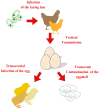Biosecurity Implications, Transmission Routes and Modes of Economically Important Diseases in Domestic Fowl and Turkey
- PMID: 40284893
- PMCID: PMC12031076
- DOI: 10.3390/vetsci12040391
Biosecurity Implications, Transmission Routes and Modes of Economically Important Diseases in Domestic Fowl and Turkey
Abstract
The poultry industry is a critical source of affordable protein worldwide; however, it faces continuous threats from various poultry diseases that significantly impact public health, economic stability, and food security. Knowledge of and examination of the transmission routes, risk factors, and environmental survival characteristics of the most important pathogens affecting poultry populations, as well as the importance of strict biosecurity, are pivotal. Transmission routes are split into direct and vector-borne pathways, and indirect ways, which include infections via contaminated surfaces and vector-borne pathways, including insects and rodents. Avian influenza virus and Newcastle disease virus spread through respiratory droplets, and their transmission risk increases with increasing stocking density. While other pathogens (e.g., infectious bursal disease virus and Salmonella spp.), to persist long-term in the environments, for example, feed and litter, increasing the probability to persist long-term in the environments, for example, feed and litter, increasing the probability of infection. The long-term resilience of pathogens in multiple pathogens in various environmental conditions highlights the role of biosecurity, sanitation, and hygiene controls in preventing disease outbreaks. High stocking density in production systems, suboptimal ventilation, and inadequate biosecurity controls further increase transmission risks. This paper summarizes important disease transmissions and reinforces the need for strict biosecurity protocols and routine health monitoring to prevent the spread of pathogens within and beyond poultry facilities. These strategies can support safe poultry production, address growing global demand, and ensure food safety and public health.
Keywords: biosecurity; food safety; poultry diseases; poultry industry; public health; transmission routes; zoonosis.
Conflict of interest statement
Authors Gerda Domaföldi, László Kovács, and Máté Farkas were employed by the company Poultry-Care Kft. The remaining authors declare that the research was conducted in the absence of any commercial or financial relationships that could be construed as a potential conflict of interest.
Figures



Similar articles
-
Influx of Backyard Farming with Limited Biosecurity Due to the COVID-19 Pandemic Carries an Increased Risk of Zoonotic Spillover in Cambodia.Microbiol Spectr. 2023 Feb 14;11(1):e0420722. doi: 10.1128/spectrum.04207-22. Epub 2022 Dec 14. Microbiol Spectr. 2023. PMID: 36515551 Free PMC article.
-
The application of biosecurity practices for preventing avian influenza in North-Eastern Italy turkey farms: An analysis of the point of view and perception of farmers.Prev Vet Med. 2024 Jan;222:106084. doi: 10.1016/j.prevetmed.2023.106084. Epub 2023 Dec 3. Prev Vet Med. 2024. PMID: 38064904
-
A Review of Eight High-Priority, Economically Important Viral Pathogens of Poultry within the Caribbean Region.Vet Sci. 2018 Jan 26;5(1):14. doi: 10.3390/vetsci5010014. Vet Sci. 2018. PMID: 29373488 Free PMC article. Review.
-
The One Health Epidemiology of Avian Influenza Infection in Bangladesh: Lessons Learned from the Past 15 Years.Transbound Emerg Dis. 2023 Nov 30;2023:6981327. doi: 10.1155/2023/6981327. eCollection 2023. Transbound Emerg Dis. 2023. PMID: 40303708 Free PMC article. Review.
-
A two-year prospective study of small poultry flocks in Ontario, Canada, part 1: prevalence of viral and bacterial pathogens.J Vet Diagn Invest. 2019 May;31(3):327-335. doi: 10.1177/1040638719843577. Epub 2019 Apr 11. J Vet Diagn Invest. 2019. PMID: 30973091 Free PMC article.
References
-
- Castro F.L.S., Chai L., Arango J., Owens C.M., Smith P.A., Reichelt S., DuBois C., Menconi A. Poultry Industry Paradigms: Connecting the Dots. J. Appl. Poult. Res. 2023;32:100310. doi: 10.1016/j.japr.2022.100310. - DOI
-
- Mottet A., Tempio G. Global Poultry Production: Current State and Future Outlook and Challenges. Worlds Poult. Sci. J. 2017;73:245–256. doi: 10.1017/S0043933917000071. - DOI
-
- Food and Agriculture Organization of the UN . FAO Agribusiness Handbook. FAO; Rome, Italy: 2012.
Publication types
Grants and funding
LinkOut - more resources
Full Text Sources
Miscellaneous

